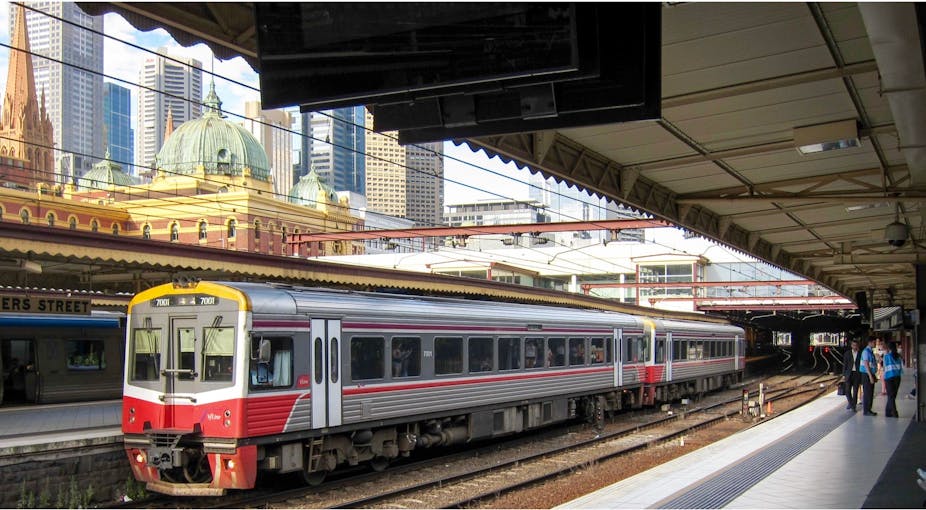There is a strong geographic element to the transitions in the Australian economy that our prime minister so frequently refers to. Generally, the old economy, based on manufacturing, mining and agriculture, provided employment and opportunity in regional Australia, whereas the new jobs in knowledge-intensive industries are predominantly created in the centre of our largest cities.
The federal government’s recent Smart Cities Plan states:
Australia’s growth as a knowledge-based economy, and the prosperity this offers, goes hand in hand with the growth of our cities and the regions surrounding them.
But how does this growth in city-centric industries translate to regional growth? Commuting may provide the answer.
That people travelling from regional areas to work in cities may distribute both financial and population growth was first proposed by Gunnar Myrdal in 1963. This applies particularly when this commuting is associated with the relocation of households from the cities.

More recently, the CLARA proposal bases regional development on high-speed city rail access and attracting commuters to new cities between Sydney and Melbourne.
In Victoria, the flight of city dwellers to picturesque regional cities and towns has received regular media coverage over the past decade. An example is the Northcote North phenomenon: 2006 Census data indicated most of the new residents of Castlemaine had relocated from Melbourne’s inner north.
Rise of the long-distance commuter
Census data also indicate that a significant number of these metropolitan escapees work in Melbourne. In Geelong, 2011 Census data show that more than 11,000 residents of the regional city travelled to work in Melbourne. That was nearly 13% of the city’s resident workforce.
This growth in commuting has occurred across Australia. Wollongong Lord Mayor Gordon Bradbery said it’s no longer a steel city but “a lifestyle city” when proposing that Sydney commuters may help offset continued job losses at the local steel plant. He said more than 20,000 of the city’s residents commute to the New South Wales capital each day.
For cities like Wollongong and Geelong, commuting may provide important economic benefits as their traditional industrial strengths decline and even close.
The increase in regional-urban commuting can be seen as not just the result of the increase in well-paid employment towards the centre of our larger cities. Rising housing costs have also played a part.
In a recent interview, a new resident of Torquay said that, for similar prices, it was a choice between the beachside town and a new housing development on the outskirts of Melbourne. Other reasons for regional relocation include friends and family, rural amenity and work arrangements for other household members, but metropolitan housing costs appear to be a significant factor.
What do regions get out of this?
Regional-urban commuters’ access to well-paid employment is an important factor in spreading economic benefits. For example, about 30% of Geelong residents who earned more than $2,000 per week in 2011 worked in Melbourne.
It is also important to note that, in 2011, more than 50% of the Victorian regional-urban commuters had changed their place of residence in the preceding five years: people are moving to commute and bringing higher incomes and families with them. There is evidence to suggest that this additional income may lead to higher regional employment in retail and service industries.

However, research indicates that many people do not continue long-distance commuting for more than a few years. This can be attributed to the links between long-distance commuting and poor physical and mental health, family problems and reduced community engagement.
Economists suggest that when deciding to commute long distances, people are not good at evaluating the non-pecuniary costs of commuting and the higher wages associated with commuting do not fully compensate for these costs.
Regional-urban commuters are more likely to work in the growing knowledge-based industries than their regional counterparts, in the census categories information, media and telecommunications; financial and insurance services; and professional, scientific and technical services.
When commuters tire of the travel, should they continue to live regionally and seek local work, this may be more significant for regional growth than the impact of the additional income. Some of these people may start new businesses closer to home, or provide a labour pool for other businesses in the area.
A survey is under way asking regional-urban commuters about their work and considerations of change. Preliminary results indicate that the main reason people start regional-urban commuting is that their work is not available where they live. Many would work locally if they could.
The tendency for commuters to find or create local employment as they tire of the time spent in transit is central to understanding how regions can grow through interactions with larger cities.
You can find project updates and the commuter survey here.

